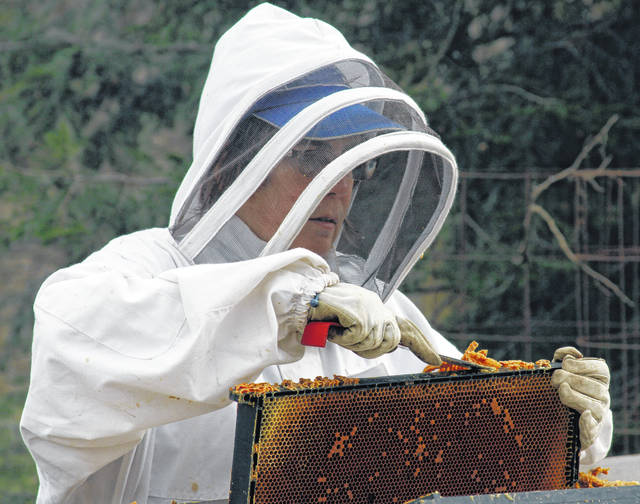

For some, it’s the excitement associated with dusting off the golf clubs or stringing new line on their fishing reels. For others, nothing signals the onset of spring like the arrival of seed catalogs in the mail, preparing the garden or sharpening lawnmower blades. Regardless of the things that occupy our time preparing for opportunities that coincide with warmer weather, we can all agree there is something special about springtime and experiencing the things unique to this time of year.
Just as our participation in a variety of spring activities signals nicer weather is coming, there is also another indication that sunshine, warmer temperatures and longer days are just around the corner. Many local bee-keepers are now checking their bee hives and making the necessary preparations to ready their equipment for the upcoming honey-production season, it won’t be long until those hives are buzzing with activity.
In springtime when things begin to warm up a little, few will notice that occasional honeybee hovering around a puddle of water or working its way through a stand of crocuses, daffodils, or dandelions. Even fewer consider the importance of that little bee and the part it plays in our lives. Yet, the more one learns about honeybees, the more fascinating they become. Evidence of our relationship with honeybees goes back a long, long, way. From biblical references to hieroglyphic images on the walls of the ancient pyramids, history indicates man has always had an appreciation and fascination with bees … and their honey!
We usually think of them living in the little white boxes sitting at the rear of one’s property, but a great number of honeybees live in the wild also and are an intricate part of the fabric of wildlife found there. Regardless of where they are, nearly everything benefits from honeybees that live in the area. It is estimated that 80 percent or more of the food we eat is connected to honeybees in one way or another and I suspect that percentage applies equally to wildlife as well. Bees and other insects are key players in the pollination process; the method by which plants reproduce and multiply. While gathering pollen and nectar from blooming plants and trees for food, honeybees pollinate the plants. The residual effects of their activity is the production of seeds, fruits, vegetables, and a variety of other foods. Bees can be found on the delicate blooms of fruit trees in the early spring gathering nectar and pollen from a variety of blooming plants all summer long, or canvasing the rich yellow tops of goldenrod in the fall. All plants benefit from the visiting bee and without them it is believed by many that life as we know it would end.
A typical colony of bees will have one fertilized egg-laying queen, a small number of male bees called drones, and up to 50,000 or more unfertilized female bees that do the all the work in the hive as well as foraging outside for the materials necessary to maintain the colony. Even in the dead of winter when most would suspect the bees are hibernating they are actually working to stay alive.
In the fall of the year when temperatures drop below 60 degrees life in a bee hive begins to change. The queen stops laying eggs and the drones who contribute nothing to the hive but the one-time fertilization of queens are escorted to the entrance of the hive and unceremoniously expelled and left to starve so as to conserver the valuable resource (honey) that will be needed to see the rest of the colony through the winter. While that may seem a little harsh, the drones are the largest bees living in the hive, consume lots of honey, and contribute nothing else to the colony; they are expendable. Not to worry though, the queen can select whether or not to fertilize an egg before she lays it. Unfertilized eggs laid by the queen produce drones, so more drones can be created when they are needed.
After the first hard frost, when temperatures grow colder, all the bees in the colony start feeding on the honey they produced and will eventually form a cluster surrounding the queen and stored honey in the center of the hive. Lower temperatures cause the cluster to tighten up and the outside layer of bees pull together to help conserve life-saving heat. Facing inward the bees in the center of the cluster “shiver” or vibrate their wing muscles without moving their wings to produce heat. With thousands of bees shivering, the center of that ball of bees can reach nearly 95 F! As the bees on the outside of the cluster grow colder, they crawl towards the center of the ball to feed, warm up, and create more heat while those on the inside move outward to take their turn shielding the rest. This rotation continues 24/7 until warmer weather arrives in spring; hence, “busy as a bee.”
Depending on weather patterns, sometime between mid-February and early April outside temperatures will begin climbing. Colonies that survived the winter begin a thorough cleaning of the hive and preparing a place for the queen to lay eggs and raising new brood. Bees also work feverishly at repairing and rebuilding other wax cells to hold pollen for feeding their young and storing a new harvest of nectar that will eventually be transformed into next-year’s honey.
It is a remarkable cycle of life and in the early summer the colony’s population generally grows to the point there is not enough room for everyone, so it is necessary for the colony to create a second queen. Eventually, either the established queen or a newly hatched one will leave the hive in a “swarm” taking approximately half the workers with her; thus splitting the colony to create another new one. Typically swarms that left their original home will gather in a ball around the queen on a tree branch, the side of a tree or structure, and sometimes on the ground. They remain there until scout bees find a suitable place for a new home; then they all go inside, set up shop, and begin manufacturing new beeswax combs for the purpose of raising new bees and storing honey for the winter … and so it has gone since the dawn of time.
When and where the subject of bees comes up, there seems to be a great deal of genuine concern shared by the public about the decline of our domestic and feral population of honeybees and other pollinators. Regardless of the reason, it is a cause for alarm and should be on the forefront of research to remedy the problem considering how it may affect what, if anything winds up on our dinner tables in the future! There are lots of facts concerning this issue, but that’s another story for another day.
Exhaustive research on bees has produced more information than one could digest in a lifetime. I’m no expert, but I have kept bees for five years, and just wanted to take this opportunity to share a little info and hopefully increase the reader’s awareness and appreciation for honeybees. They are truly amazing! And while a clump or “swam” of honeybees hanging on a tree or shrub near one’s house may seem frightening, swarming bees are generally not very aggressive. However, one man’s threat is another man’s treasure, so do not hesitate to give me a call at 937-492-7034, and if I’m available, I will gladly come and remove that clump of honeybees and give them a new home.



